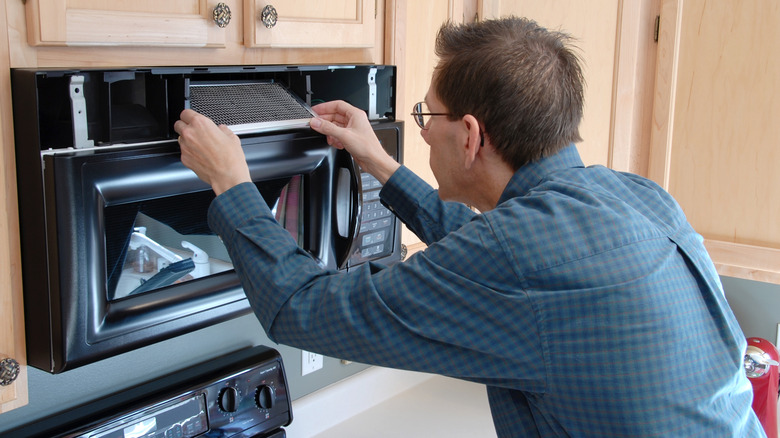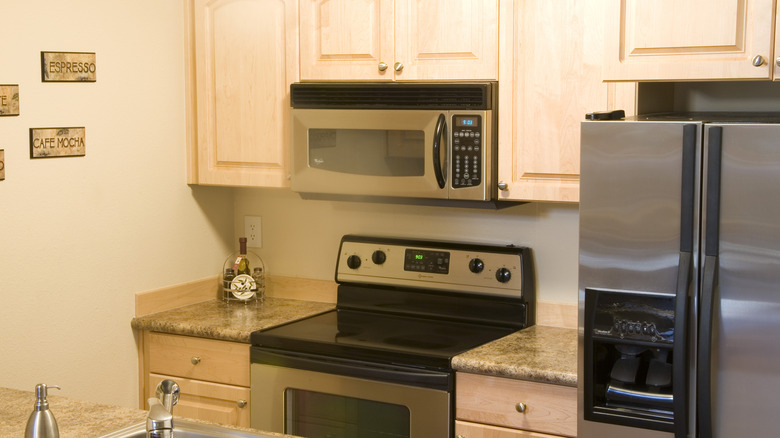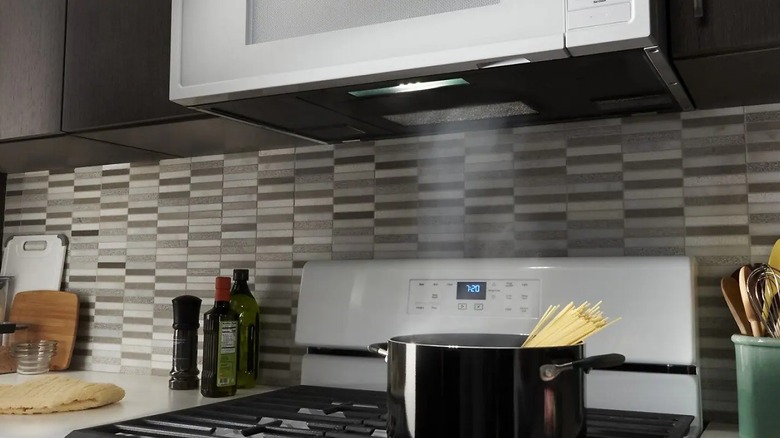Did You Know Your Microwave Has A Filter? Here's How (And Why) You Should Clean It
A microwave is far from being a home appliance that's a complete waste of money. It has a ton of uses in the kitchen, from reheating meals and thawing frozen meats to disinfecting sponges and sterilizing jars. But more than being a versatile gadget, one thing users also love about the microwave is that it's low-maintenance when it comes to cleaning. All it takes is a quick wipe, and you're pretty much done.
But besides the interior and exterior, your microwave might have one more thing that needs cleaning: its filters. This doesn't apply if you have a counter-top model, but if you have an over-the-range microwave, it comes with at least one filter. You might not see them at first glance, but they're there and quietly working to keep your kitchen air clean. Over time, they accumulate dirt and require some attention. So what exactly are these microwave filters? What do they do, and why should you bother cleaning them?
Microwave filters and why they matter
Over-the-range microwaves — from both cheap and major microwave brands — have filters for a reason. The most common type of microwave filter is called a grease filter, the mesh-like plate on the bottom of your microwave. On some models, you can find only one grease filter, while on other models, there are two or more. The grease filter is designed to trap grease, bits of food, and other unwanted particles coming from the stovetop before they reach the microwave's vent system.
If your over-the-range microwave doesn't have a duct that vents air outside, the unit likely has a second type of filter: a charcoal filter. It looks like a black felt pad, which is either attached to the grease filter or installed separately on top of the microwave, depending on the model. The charcoal filter absorbs strong odors from the stovetop to keep the circulated air fresh.
It's important to clean the microwave's grease filter at least once every month. Otherwise, grime buildup can clog the vent fan and prevent it from effectively circulating air. The charcoal filter, on the other hand, is disposable and generally lasts up to six months. After that, it might not remove odors and smoke just as well, so you'll need to replace it if you don't want your kitchen to end up smelly. If you often use the stovetop, it's a good idea to buy a replacement filter earlier, at around the three-month mark. But if you don't cook as much, you can opt to replace the filter after seven or eight months.
How to clean your microwave filter
Some grease filters are dishwasher-safe, so you can just pop them in your dishwasher and go on your merry way. There are, however, filters that can't go in the dishwasher. If you're not sure which type you have, you can just wash them by hand. Here's how to do so safely:
- Unplug your microwave from the wall outlet.
- Remove all the filters from the bottom of the appliance. Depending on the model, you might need to use a Philips screwdriver or simply slide the filters out from the slot.
- Mix hot water, dish soap (or mild detergent), and a quarter cup of baking soda in a basin. Don't use ammonia or alkali-based cleaning agents to avoid darkening the metal.
- Soak the filter in the basin for ten minutes or more.
- Clean it gently with a soft dish brush. Avoid bending the filter or frame.
- Rinse the filter in hot water.
- Pat it dry with a clean cloth.
- Reinsert the filters back into the underside of the microwave.
If your microwave includes a filter reminder feature like on some Samsung microwaves, you might need to reset it after putting the filters back in. Consult your owner's manual on how to do so. On some microwaves, the charcoal filter already comes off with the grease filters, so you can replace it right away. But if it doesn't, it might be fitted on top of the unit instead. Follow these steps to replace the microwave's charcoal filter:
- Unplug the microwave and open the door.
- Unscrew the vent grille at the top of the unit.
- Remove the vent grille by pulling on it.
- Take out the charcoal filter from behind the grille.
- Inspect the filter for dirt or discoloration.
- If it looks dirty enough, throw it away.
- Reinstall the filter and grille.
Make sure you return all the filters properly before turning on the microwave.


